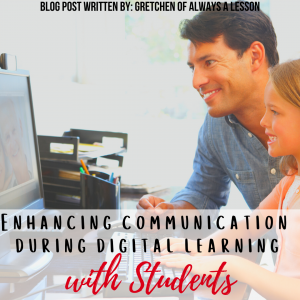Enhancing Communication during Digital Learning with Students
Communication during digital learning can be an obstacle, but not an insurmountable one.
This series of posts will outline ways to communicate with various stakeholders (parents, colleagues, and administrators) during digital learning as well as share what type of information to communicate.
Although digital learning looks different for everyone right now during Covid-19 shutdowns, the truth is no one is exempt from digital learning in some form or fashion. Distance learning is here to stay for the foreseeable future which means we better figure out how to make it successful.
Enhancing communication is essential to continue on a path of learning and growth for stakeholders like administration, colleagues, students and parents.
 Enhance Communication with Students
Enhance Communication with Students
-
- Personal connections– Make time to get to know your students on a personal level. A lot of time is dedicated to understanding your students as academic learners and not people. Personal connections are oftentimes the spark that pushes students to new heights in the classroom and beyond. Build time into your schedule to connect.
- 1:1 check ins– Many times students will not share personal information with you (ie. changes at home, academic struggles, etc.) during virtual learning because other students are present. Create 1:1 opportunities to check in on students, even when things are going well. This informal data will guide your teaching so that it becomes better personalized for every student.
- Specific and thorough feedback– Students are often learning virtually for the first time. They are unsure of how to complete assignments and want to do their best. Be sure to provide specific and thorough feedback on assignments so students know what they did well and where they need to improve. Nothing is more frustrating than a grade without a description. Provide guidance and support through your feedback.
- Public celebrations– Call out what is going well. You can do personal shout outs for a job well done or group trends you want to call attention to. Either way, taking time to publicly celebrate enhances the culture of your online classroom.
- Facilitate student to student communication– Communication is not a one way street, beginning with the teacher. Build in opportunities for students to collaborate with each other during lessons and outside live sessions. Pair up students, provide guidance on what to do, and follow up with an accountability piece. For example, you can share a document listing student pairings with written instructions on what students are to discuss together. Then, you might have them draft a summary or reflection of their chat so you can account for the discussion while gathering informal data.
- Provide clear goals & a pathway to get there– To help students become successful in your classroom, provide clear goals so students know the expectation of where they are to go (ie. proficiency levels, project outcomes, etc.). More importantly, give students the pathway to reach those goals (ie. mini project check points or student data tracking binders). When students know what they need to do and how they need to do it, they are able to rise to the occasion.
Consistent, on-going communicating with stakeholders during remote learning is of utmost importance to make the school year successful for all. Using communication tools like Google Meet, Skype, Zoom and FaceTime are great for connecting face-to-face in a virtual world. Using Voxer, email, and text are helpful to staying connected on a daily basis through voice or print.
Whatever tool or strategy you employ, enhancing communication during remote learning is the goal to success for everyone involved.
Need resources for communicating with students? Click here.
How are you communicating with students during remote learning?


 Get Edu-Tips, Freebies and grab your FREE Study Guide for Gretchen’s New Book!
Get Edu-Tips, Freebies and grab your FREE Study Guide for Gretchen’s New Book!